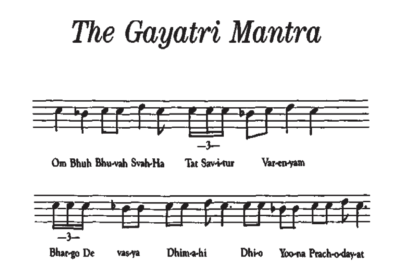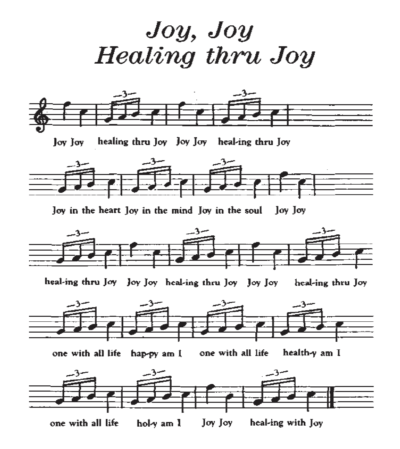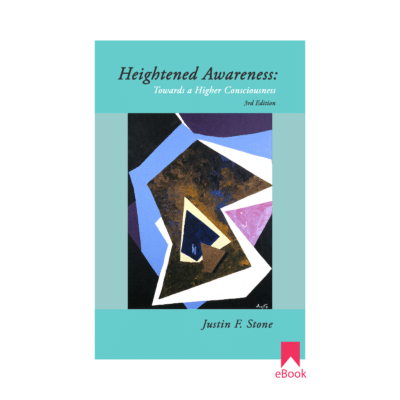
In India the people speak of “vibration before sound,” the catalyst for the beginning of creation. This probably has the same meaning as, “In the beginning was the Word.” Almost all beliefs agree that sound is the matrix of creation. The fanciful phrase “music of the spheres” has more truth to it than is generally known. Many mystics have reported hearing celestial music constantly.
Today medicine is beginning to use ultrasound for its healing properties, recognizing that this unheard sound can have great effect on the muscular and, probably, molecular makeup of the body. Those who live in big cities, with the constant noise of traffic, jackhammers and the frequent shrill sound of sirens, suffer a good deal without knowing it. It is not only the loss of comfortable sleep because of noise that is harmful; the continued harsh vibration has a detrimental effect on the character of the Chi. Such irritation causes blockage and makes it difficult for the Chi to flow freely through the meridian channels of the body. Since the flow of the blood follows that of the Chi, it can readily be seen how heart trouble and other ailments can develop from these tensions. As for the overpowering blasts from rock bands, these not only cause hearing impairment, but also bring about an irritable agitation and restlessness that are natural predecessors to the use of drugs.
There are ordinary people who are so engulfed with the pressures of continued sound that they cannot be without it. They awaken and turn on the radio, leave the television sound on as they move around the house, and have noise (or music and talk) cascading over them every moment they are awake. They cannot take silence.
To those who walk or drive through deserted sections of the desert, the intense silence – certainly more than the mere absence of sound – can be very healing. Silence and cool green foliage in other localities should be bottled and dispensed to people, probably doing much more for them than talking-about-themselves sessions on the psychoanalytic couch do. The vast silence and the broad, restful vistas of nature (there are few displeasing sights in nature) can be healing to us all. The countryside that has long, sweeping, unhindered views is good for meditation, and there are many such in India, as there are in the western parts of the United States.
∞ ∞ ∞ ∞ ∞ ∞ ∞ ∞ ∞
Our first practice using sound is a simple one: just sit or stand where you are, take a few deep breaths, then relax and notice all the near and distant sounds of which you were unaware a few minutes ago. Make a mental note of each. The humming of a plane overhead, an ambulance in the distance, house noises, the sound of tires on the pavements, the chirping of crickets and birds, a female voice calling out to someone, a trombone playing soulfully on a radio somewhere … All these and more may be happening, and yet you have not noticed them; your busy mind has not registered the sounds at all. “Listen to that trombone,” states a jazz lover in an admiring tone of voice. “What trombone?” you ask, mystified.
Do not embroider the sounds. Register only what you hear, using no imagination. If the sound is that of tires on wet pavement, then just note that; do not imagine the passing car.
This is not easy to do; it demands strict attention. It also means we have to drop our egoistic self-centered concerns, forget our worries and memories, and just turn ourselves over to the hearing organ, registering only what we actually hear.
After a few minutes it would be good to break off for a short interval, then take up the practice again. If this practice should carry over into your everyday life, you would have taken the first step toward real mindfulness.
As we continue, relaxed yet concentrated, in this choiceless awareness, more and more sounds will intrude upon our consciousness. And if we are really sensitive, we will also be aware of silence when it is there. Probably a ringing in the ear or some other bodily sound will intrude. A building is always making noise; groups of people include some who cough or sneeze. Heating and air conditioning devices make noise. It will become apparent that we are engulfed in an ocean of sound; so let’s become aware of it.
When we have listened to random sounds for a while, let’s turn to something pleasant, where we control the object of hearing. Let’s listen to music.
Play some pleasing music, but not loudly. Hear the music, the instrumentation of the orchestra, the singer’s voice – all without mental comment. Just sink into the music and really hear it. Not many really listen to music; their thoughts begin to drift, and pretty soon they are daydreaming. While listening to the music, be aware if the mind starts to drift off and quickly bring it back to the focal point, the music. This may be more difficult than it seems, but be sure to persevere.
Music is unlike the other arts; indeed, unlike anything in life. It goes right to the heart, affecting the emotions, without going through the intellect. We don’t have to analyze music to enjoy it. The writer many years ago studied the Schillinger System, the mathematical theory of music, and some of what was learned went into devising music for therapy, a very potent weapon that seems completely ignored in the field of psychology (perhaps because of the love of words). Incidentally, to decide what previously composed music was most beneficial, we mathematically analyzed the works of Bach, Mozart, Scarlatti, Debussy and others. To my surprise, Mozart’s music proved to be the most perfectly constructed mathematically and would afford the greatest feeling of rest.
When we have finished just being aware of the sounds of music, we should extend the practice by now playing several different CDs and becoming aware of whether they are pleasing, displeasing or indifferent in their effect on us.
Discussion of these judgments would only cause argument and spoil the practice. Rather, each student should merely note, as he or she hears the music, whether he is enjoying it, is indifferent to it or dislikes it.
One day many years ago, in the Himalayan foothills, the author was driving north in an old touring car with a companion who was at the wheel. There was a medium-heavy rain falling. Suddenly, directly ahead, an open and flat truck carrying a load of hay-like material appeared. Standing atop the hay in the pouring rain, waving his arms in the angular fashion of Indian dance, was a teenaged youth, naked except for a loincloth. The water was streaming down his face and his hair was disheveled. He was laughing ecstatically. As we were passing the truck, he brought a flute to his lips and began to play as he danced. Only for a moment could I hear the sound. Never had I heard a purer one. The tone of the flute coming through the rain was clear and angelic. As I looked back (we passed rapidly), I could see the dancing figure, moving in ecstasy, while my ears began to pick up the sounds of the road. I was sure I was looking at the god Krishna and his flute. Such purity of sound I have not been aware of again.
∞ ∞ ∞ ∞ ∞ ∞ ∞ ∞ ∞
Chanting can be enchanting. The power has nothing to do with the semantic meaning of the sounds – we can chant in Latin, Chinese or Sanskrit and derive great benefit.
For practice in chanting we are going to use the Gayatri Mantra, which in India is supposed to be suited to all people anywhere. It has a good vibration and is fun to chant. In a class I gave at the University of New Mexico, students chanted the Gayatri at sunset as one of the members of the class kept time on his bongo drum (not my idea). It was fun.
The Gayatri is often sung, with notes rising one tone or descending one tone from the tonic. However, it is very effective just being chanted. The sounds (Sanskrit) are as follows:
OM BHUH BHUVAH SVAH-HA
TAT SAVITUR VARENYAM
BHARGO DEVASYA DHIMAHI
DHIO YOO-NA PRACHODAYAT
This should be chanted firmly and evenly. Once the sounds are memorized, one can chant as he or she walks along the sidewalk (mentally if desired), keeping in time with the footsteps. In India chanting is often timed to be in rhythm with the breath.
A mantra is a sound or series of sounds apparently revealed to a rishi (sage) during periods of austere practice. Two such sages in India’s history – the ancient Yogi Vashishtha and the modern Ramana Maharshi – are known as Great Rishi, or Maha Rishi in pronunciation. Some present-day teachers have arbitrarily taken this title for themselves, but without general recognition in India.
The spiritual meaning is not of interest to us here, nor is the fact that Gayatri, in effect, is the Sun Goddess. We are using the Gayatri Mantra as a vehicle to help us in our progress toward heightened awareness. For the same reason we are not going to use prayer in our practice because it would involve us in religious matters, and greater awareness – not denominational faith – is our goal.
∞ ∞ ∞ ∞ ∞ ∞ ∞ ∞ ∞
There have been many uses for aphorisms, phrases repeated to the self so that they will sink into the subconscious. Particularly where business success is the objective people have listened to motivational CDs, and they can be quite useful in strengthening the confidence and the drive for success.
We are going to approach the subconscious by singing a pleasing song (by the author, an A.S.C.A.P. composer) that makes use of the powerful vibrations of the word “joy.” Other inspirational words occur in the song. It is the writer’s feeling that, as we approach joy, we approach Divinity. Many ashrams in India have the Sanskrit word Ananda in their names, and Ananda (or Anand) means Bliss. This feeling is far from the satisfaction of having a desire gratified. Bliss is an inner thing, our real nature shining through. The words are as follows:
Joy, Joy, Healing thru Joy
Joy, Joy, Healing thru Joy
Joy in the Heart, Joy in the Mind, Joy in the Soul
Joy, Joy, Healing thru Joy
Joy, Joy, Healing thru Joy
Joy, Joy, Healing thru Joy
One with all Life, Happy am I
One with all Life, Healthy am I
One with all Life, Holy am I
Joy, Joy, Healing with Joy
This winds up our practice with sound. Many have had an enlightenment experience (Satori) by hearing a sudden sound. This writer can refer to a time when, sitting in the house in meditation, he heard a bird chirping outside (which was felt to be inside the sitter), and suddenly for a moment, everything seemed clear in a complete unity. Striving to grasp the details so I could remember the experience, I found that it gradually faded and there were no details to recall, but the effect was powerful.
Similarly, a disillusioned monk, while mowing the grass one day, tossed aside a small piece of tile and was completely startled when it struck something with a large bang – startled to the point where thinking stopped momentarily and there was a complete Satori experience. Of course, this monk had spent many years in preparation for this sudden enlightenment by unexpected sound.
Whether chanting, singing or hearing silent sound, there is no more effective way to culture the mind for heightened awareness.



